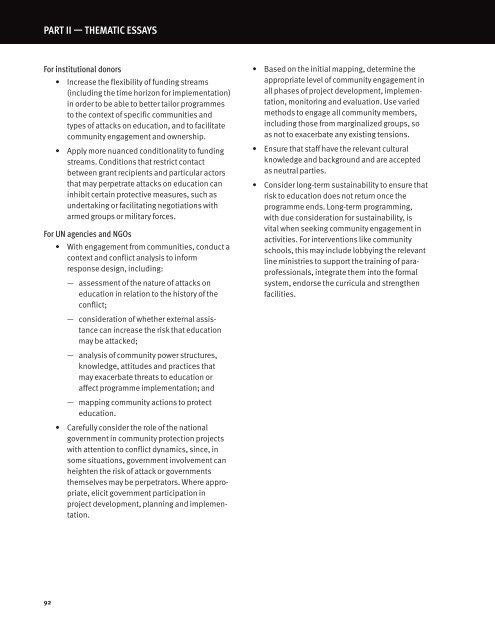Create successful ePaper yourself
Turn your PDF publications into a flip-book with our unique Google optimized e-Paper software.
PART II — THeMATIC eSSAYS<br />
For institutional donors<br />
• Increase the flexibility of funding streams<br />
(including the time horizon for implementation)<br />
in order to be able to better tailor programmes<br />
to the context of specific communities and<br />
types of attacks on education, and to facilitate<br />
community engagement and ownership.<br />
• Apply more nuanced conditionality to funding<br />
streams. Conditions that restrict contact<br />
between grant recipients and particular actors<br />
that may perpetrate attacks on education can<br />
inhibit certain protective measures, such as<br />
undertaking or facilitating negotiations with<br />
armed groups or military forces.<br />
For UN agencies and NGOs<br />
• With engagement from communities, conduct a<br />
context and conflict analysis to inform<br />
response design, including:<br />
— assessment of the nature of attacks on<br />
education in relation to the history of the<br />
conflict;<br />
— consideration of whether external assistance<br />
can increase the risk that education<br />
may be attacked;<br />
— analysis of community power structures,<br />
knowledge, attitudes and practices that<br />
may exacerbate threats to education or<br />
affect programme implementation; and<br />
— mapping community actions to protect<br />
education.<br />
• Carefully consider the role of the national<br />
government in community protection projects<br />
with attention to conflict dynamics, since, in<br />
some situations, government involvement can<br />
heighten the risk of attack or governments<br />
themselves may be perpetrators. Where appropriate,<br />
elicit government participation in<br />
project development, planning and implementation.<br />
• Based on the initial mapping, determine the<br />
appropriate level of community engagement in<br />
all phases of project development, implementation,<br />
monitoring and evaluation. Use varied<br />
methods to engage all community members,<br />
including those from marginalized groups, so<br />
as not to exacerbate any existing tensions.<br />
• Ensure that staff have the relevant cultural<br />
knowledge and background and are accepted<br />
as neutral parties.<br />
• Consider long-term sustainability to ensure that<br />
risk to education does not return once the<br />
programme ends. Long-term programming,<br />
with due consideration for sustainability, is<br />
vital when seeking community engagement in<br />
activities. For interventions like community<br />
schools, this may include lobbying the relevant<br />
line ministries to support the training of paraprofessionals,<br />
integrate them into the formal<br />
system, endorse the curricula and strengthen<br />
facilities.<br />
92


